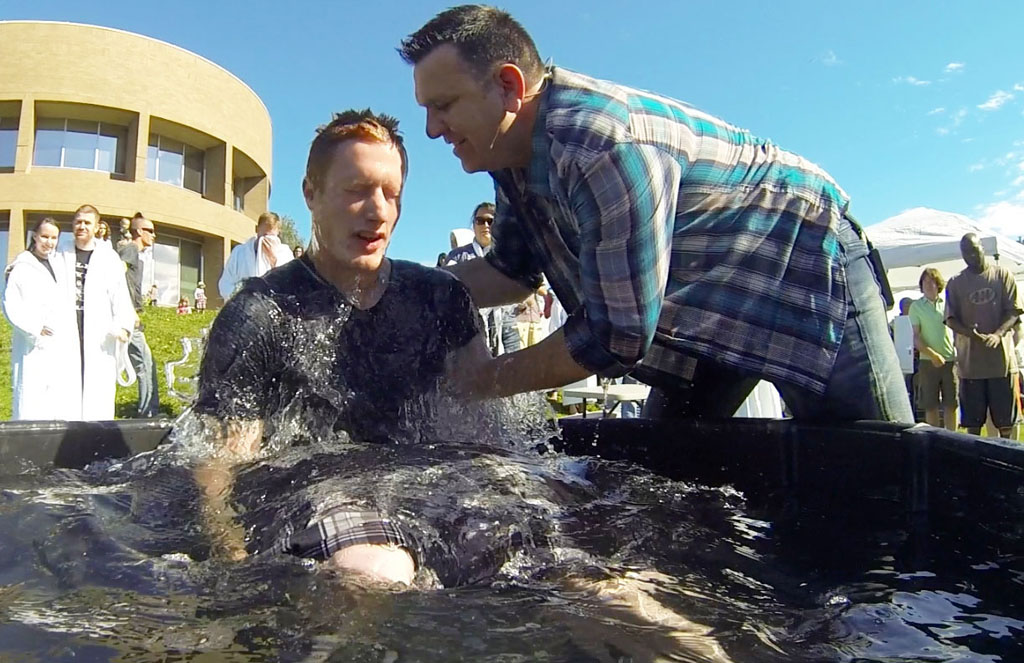
[SLIDESHOW=39101,39102,39103]ANCHORAGE, Alaska (BP) — Jason Storter had no interest in church when his wife Mariah asked him to join her at a new Anchorage church plant.
An avowed atheist, Storter told Brent Williams, pastor of True North Church, he was only attending to make his wife happy. He said he’d be gone when football season started and didn’t plan to get “duped by this Jesus-stuff.”
Williams didn’t bat an eye, saying with a smile: “That’s fine. Truth North is a place for you. It’s a place for you to come and get your questions answered so your wife is happy and your life is happy.”
Over time, Storter’s walls began coming down, and he and Williams started meeting for coffee. On one such occasion, Storter mentioned he needed to get his house painted and a couple of his friends had bailed on him. A thought came to Williams’ mind: Could the mission team in town from a Texas Baptist church help Jason? A few hours later the mission team had stripped the paint off the house and was spending the afternoon getting to know Storter, who couldn’t seem to understand why these people from Texas would help him and ask for nothing in return.
“A couple of weeks later, after church, he rolled down his window and said, ‘Brent, today I was duped by Jesus.’ I said, ‘What do you mean?’ And he said, ‘Jesus is my Savior,'” Williams recounted.
Three years later, Storter is a life group leader at True North, serves in the church’s children’s ministry and has led others to faith in Christ.
Only five years after Williams moved to Alaska from Texas to begin the work of church planting, True North averages around 300 in weekly attendance.
Thanks to True North and a growing number of Alaska Baptist church plants, people far from God in the Land of the Midnight Sun are coming to faith in Christ. Prior to 2012, Alaska Baptists had planted, on average, one to two churches a year.
Church planting in the state had slowed so much by 2011 that Mike Procter, the executive director of the Alaska Baptist Convention, told the North American Mission Board his state wouldn’t need the $150,000 NAMB was providing Alaska for church planting the following year. NAMB then allocated the money elsewhere. By the following year, the situation had reversed. New church plants in the state were on the rise. Procter then asked for an additional $100,000 to fund the flurry of church planting requests coming in. NAMB sent the funds.
Steve Bass, NAMB’s West Region vice president, remarked, “Even though Southern Baptists have had this incredible interest [in church planting] in the urban centers, we’ve got Alaska, a rural state convention, that is nowhere near an urban center and God has blessed them in an incredible way.”
In 2012 and 2013, Alaska Baptists planted 19 churches.
That blessing comes to a state with big spiritual needs. Only one in three Alaskans are claimed by any religious body, according to data from the Association of Religion Data Archives. The state has one evangelical church for every 1,070 people and one SBC church for every 7,101 residents, according to the NAMB’s Center for Missional Research.
Procter suggests the increase in church planting has been an answer to fervent prayer for God to send laborers.
“We have a prayer strategy called 938, where every morning at 9:38 and every evening at 9:38 we encourage people to pray unto the Lord of the harvest for Him to bring laborers,” Procter said of the prayer emphasis named after Matthew 9:38. “We’ve been doing that over the past few years and people have been sensing God’s call to come and partner with us in Alaska.”
It hasn’t just been outside laborers who have come to Alaska to start churches. Larry Macknicki, who has been in the state since the 1980s, is a former atheist with a stark conversion story from five years ago. Macknicki was in a low-paying computer programming job in 2011, trying to make sense of where God had him. As he did so, he began reflecting on the question, “What would Jesus do?” in relation to his work environment.
“The answer was very, very obvious,” Macknicki said. “Jesus would be reaching out to those He had placed around me and tending to their spiritual needs.”
Macknicki started In His Steps Community Fellowship in what he calls a “secular place at a secular time” to try to reach people like his co-workers with the Gospel. At the time, he didn’t even see it as a church.
“We don’t have huge numbers of people coming in yet, but the people who are coming in are the people who are broken, who are spiritually [young] or just spiritually dead,” said Macknicki, who also pastors a second church in nearby Wasilla. “In my congregations, God isn’t moving in a mighty numbers kind-of-way, but in a mighty growth kind-of-way in the people He is bringing.”
Despite the increasing number of church plants in Alaska, Procter said the work isn’t done. He points to the spiritual needs in the state’s largest city as an example.
“If every church was filled to capacity with current seating, we’d only have enough seats for 5 percent of our population in Anchorage,” Procter said.
“Send your best people to Alaska. Keep praying. Keep supporting the Cooperative Program,” he said to Southern Baptists, whose gifts in their churches support national and international missions and ministry.
Visit www.namb.net/mobilize-me to find out how God could use more Southern Baptists and their churches in Alaska.
















